National Flood Resilience Strategy: consultation analysis
Analysis of the responses to the National Flood Resilience Strategy consultation exercise.
1. People
People and communities are placed at the centre of the Strategy so it will be vital that people are included in the decision-making process for their places and are given the right information and evidence to enable them to contribute. Helping people to understand their exposure to flooding, what actions might help their community become more flood resilient and how they can contribute is a key part of this.
Question 4: What support do communities need to become involved/engaged in climate adaptation and flood resilience planning?
Around 185 respondents answered Question 4.
There was reference to the need to increase community understanding of the current and future threats from flooding, in particular in coastal areas. It was noted that this will require the dissemination of clear information and coherent messages, with communities given the power and agency to lead on climate adaptation and flood resilience planning. Community council or group respondents were amongst those suggesting that raising awareness on the impact of flooding now, and in the future, can help people understand that their individual actions can make a difference.
Capacity and resources
Community councils or group respondents were also amongst those highlighting concerns around a perceived lack of understanding from government about stretched capacity of community councils and other local organisations, and their ability to take on more. There was a consensus across a range of respondent types that local groups and community organisations will require a range of support to become engaged and involved including financial resources and the assistance of impartial experts providing professional advice, alongside realistic timescales.
Some respondents commented that communities and the relevant authorities must work together collaboratively, with communities given equal status, and having a voice that is listened to, in decision-making. It was observed that this may require a change of mindset by some local authorities. Respondents across a range of types suggested that the provision of practical support such as childcare and financial incentives will encourage people to engage, with education and training also seen as having a part to play in raising awareness and increasing community capacity. It was acknowledged that engaging with communities requires staff and funding, and community development support to inform and empower people.
The need for engagement to begin early in the process was stressed. Current planning mechanisms, including Local Development Plans and Local Place Plans, were seen as useful ways of encouraging engagement and discussion of potential options. Community based flood resilience groups (where they exist) were also seen as a useful starting place for community engagement.
It was argued that the need for community involvement arises because SEPA, local authorities and the Scottish Government cannot tackle flood resilience alone and that the long-term effectiveness of flood resilience is reliant on the ability of communities to understand the risks, develop plans, and implement climate change adaptation, albeit with Scottish Government, local authorities and their partners guiding the process.
Funding
Lack of financial resource was highlighted as a specific barrier to Community Councils or other local groups being involved and improving flood resilience, with Community Council or group respondents noting that funding could be used by communities to develop and implement ideas, but that access to securing finance and support needs be more straightforward. There were also concerns that applying for grant funding was not always successful, even after considerable time and effort had been expended.
Information and awareness raising
Some respondents observed that, whilst there is information available to members of the public and community groups, it is provided via a complex landscape of organisations, with websites that can be information-heavy, rather than user friendly. Additionally, content can be conflicting and not tailored for specific communities and audiences, including people who require information to be in accessible and inclusive formats.
Respondents from across a range of respondent types, including Individuals and Community Council or group respondents, argued that communities should have access to reliable, unbiased information and to advice from independent, trusted sources, such as existing flood risk partnerships and the Scottish Flooding Forum. Technical and scientific advice should be provided in a format and style that is easily understood by a non-technical audience.
Suggestions on modes of communications included using digital channels to distribute information, holding meetings and establishing/running forums.
Schools
Some respondents highlighted the importance of involving schools to raise awareness of the issues amongst young people. It was suggested this should be positive and focus on how young people can act to support climate adaptation, to prepare them to be involved in future.
Practical measures
Some respondents also took the opportunity to highlight practical measures which could support communities. These included:
- Funding for resilience centres.
- Subsidised flood protection measures.
- Addressing weaknesses in flood defences (with co-operation between the local authority and SEPA, and with the Scottish Government providing funding).
- Incentivising options to support resilience at property and community level, such as water butts and flood pods.
- Up to date flood mapping and information on predicted flood risk.
- A national programme to deliver a baseline dataset for designing flood resilient places, to increase overall public trust in the information provided.
- Flood Performance Certificates, to provide householders with an accurate assessment of their home’s current resilience, and an understanding of further measures they can implement.
Question 5: What should local authorities be doing to ensure meaningful community participation when taking decisions about improving flood resilience?
Around 170 respondents answered Question 5.
Community requirements
Some respondents, including a number of Individuals, were among those commenting that, to ensure meaningful participation, local authorities must listen to communities. The importance of engaging with communities early in the decision-making process was highlighted by respondents from across a range of respondent types, as was the necessity for ongoing communication. The need for equal partnership between local authorities and communities was also stressed.
It was noted that although communities have detailed local knowledge, they would benefit from access to technical flooding expertise and localised information and data. Individuals and Community council or group respondents were among those suggesting that access to local authority flood teams and flood mapping would be helpful. Other suggestions included that:
- Local authorities could help build capacity for community flood groups and engage with those already in place.
- Pilot projects and demonstration sites could be developed to showcase reliance measures.
A Community council or group respondent supported the idea of communities being given permission to develop and deliver ideas for improving flood resilience.
More generally, there were comments that, for communities, participation requires time, funding (including for professional advice and research), a multi-sector approach from local authorities, and access to specialist expertise and information.
Other comments focused on the need for communities to be involved in decision-making. Some respondents referenced the importance of transparency in relation to various aspects of participation, from the initial stages of communication to decision-making. Transparent decision-making was seen as including communication on how feedback has been incorporated with the rationale given for final decisions. A need for clear delivery frameworks was also highlighted.
Approaches to community participation
Some respondents highlighted active engagement, inclusiveness, and genuine dialogue as being important for successful community participation. There were references to the National Standards for Community Engagement and a Third sector respondent recommended the Volunteer Charter as the basis for relationships between local authorities and community organisations.
Other respondents mentioned specific methods that could be used to support community involvement. These included:
- Co-design using neutral facilitators.
- Collaborative approaches based on the Place Principle.
- Using the Planning for Real process.
- Setting up a Citizens’ Panel.
Some respondents focused on the need to avoid duplication in community engagement. In addition to involving Community Councils, there was support for utilising a number of existing community groups and engagement networks, including those involved in the spatial planning system and Regional Planning Strategies. Local Development Plans and Local Place Plans were also seen as providing opportunities for meaningful community participation, including on flood resilience and it was suggested that Regional Land Use Partnerships could be a useful forum for engagement and ensuring that land managers are involved. A Professional or representative body respondent suggested that flood resilience efforts could be aligned with fisheries management plans.
Mechanisms
A number of practical ways of engaging communities were suggested, with both online and face to face interactions viewed as important. These included:
- Using social media and websites.
- Public meetings, forums, briefings, exhibitions and visual modelling of issues.
- Workshops, training and other events.
- Information campaigns and surveys.
- Leaflets and information in local shops and on community notice boards.
The need for a human point of contact was also highlighted by some, with door-to-door visits suggested in at risk areas, to provide flood resilience advice. It was suggested that financial incentives could also be offered to encourage people to attend focus groups and other events, and that events need to be timed to allow those working shifts or those needing childcare to participate. A Local authority respondent commented that SEPA and Scottish Water also have a role in directing the public to relevant information.
It was stressed that information should be clear, and accessible and that local authorities must actively involve organisations representing deaf and disabled people when devising flood resilience policies and measures.
Some other respondents mentioned the need to work with schools, with a Local authority or respondent suggesting that other flood risk partners including SEPA, Scottish Water and the Scottish Flood Forum could play a part in making presentations to schools.
Issues for Local Authorities
A number of respondents raised specific issues relating to local authorities, which are summarised below.
Resourcing engagement
Respondents highlighted that local authorities require funding and resources for meaningful participation, including resourcing for planning departments. It was suggested that Scottish Government funding could made available for the appointment of a Community Flood Resilience Officer for each local authority, to work with Community Councils and advise on local initiatives.
Training and development needs
Training needs within local authorities for those officers involved in community engagement were also highlighted, with training in facilitation and engagement methods suggested, along with improved communication skills. Making training and information on flood management and related issues available for councillors and officers was also suggested.
Partnership working
Other comments emphasised the need for partnership working, with the possibility that local authorities might need third-party support to involve communities. Community groups, local housing associations and third sector organisations were suggested as trusted messengers.
The importance of cross boundary collaboration was also raised, as flood resilience measures taken in one local authority may impact on other local authority areas.
Question 6: What would help communities understand their current and future flood exposure and the range of options available to them to help them become more flood resilient? (Please rank from most to least important)
Five options were presented at this question:
- Access to flood maps showing current and future flood exposure
- Access to local flood history
- Access to information on community ‘self-help’ options
- Access to flood resilience advice/support
- Access to information on the range of flood resilience options available for their community.
Around 180 respondents responded to this question.
Preferred options
As illustrated in Figures 5 and 6, respondents thought that the most important ways of helping communities were ‘having access to flood maps showing current and future flood exposure’, followed by ‘access to flood resilience advice and support’.
‘Access to flood maps’ was seen as most important by 57 respondents and ‘access to advice and support’ was ranked as second most important by 41 respondents.
The remaining three options (access to local flood history, information on community ‘self-help’ options and to information on the range of flood resilience options available for their community) tended to then be ranked relatively evenly.
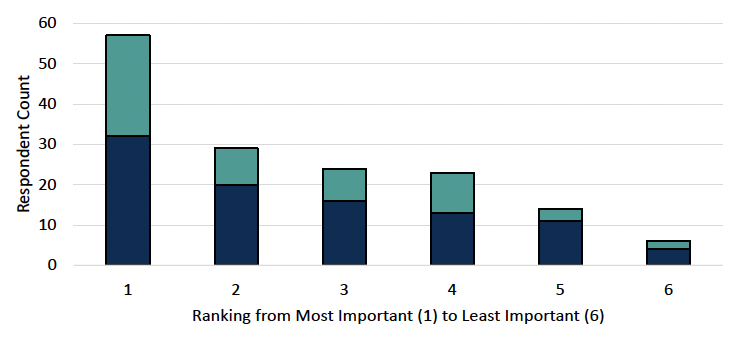
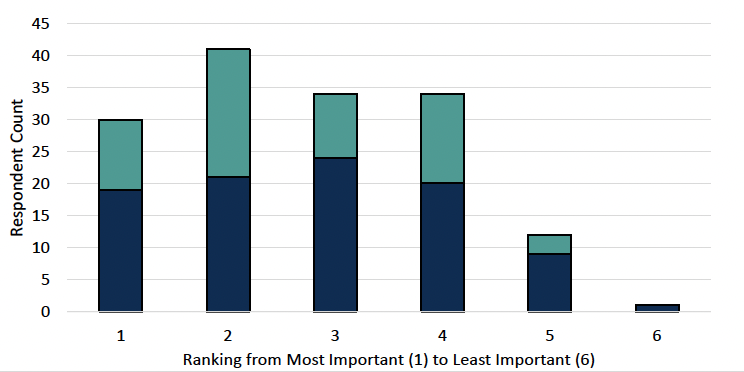
‘Other’ suggestions
Around 85 respondents made a further comment in relation to the ‘Other’ option.
Among suggestions for ‘other’ things that could help communities to become more flood resilient, the most frequent were:
- Raising awareness by including flood risk as a criterion in Home Reports or including flood risk in Local Development Plans.
- Funding – either to community organisations, or for individuals to improve the resilience of their own properties. Funding should be streamlined.
- Access to improved or additional information, such as: real-time hydrological data; regional flood alerts and local flood warnings; and explanations of how local catchment areas work or catchment-wide natural flood management options. All data should be publicly available in full, free of charge and in a range of formats. One suggestion was that there should be a statutory duty for public and private bodies to disclose any information that may reduce risk in relation to climate change.
- Access to independent expert advice, specialist guidance and support, for example help to better understand flood maps or return periods, or by providing practical information on up-to-date techniques for mitigating flooding.
- Raising awareness of flood risk, including by holding events for communities at risk of flooding to provide information on insurance, grants and schemes to help provide support or to allow members of the community to have their questions answered. Raising awareness of flood risk in local schools.
- Access to case studies to show the value of mitigating actions taken in similar communities.
Other ideas included:
- Strengthening the role of the Scottish Flood Forum.
- Improving relationships between public sector staff and communities. One view, from a Community Council or group respondent, was that the ability of a local authority to identify both a problem and a solution without sharing all the information on which they have based their decisions can lead to a break-down of trust.
Question 7: What actions could communities take to improve their flood resilience? (Please rank from most to least important)
Four options were presented at this question:
- Set up a local community flood resilience group
- Develop a local community flood response plan
- Share local knowledge of what happens during floods with organisations like SEPA and local authorities
- Link up with their local climate action group.
Around 170 respondents responded to this question.
Preferred options
‘Setting up a local community flood resilience group’ and ‘developing a local community flood response plan’ tended to be seen as more important than the other two options.
‘Setting up a flood resilience group’ was seen as most important by 63 respondents, while 70 respondents ranked ‘developing a flood response plan’ as the second most important action that communities could take.
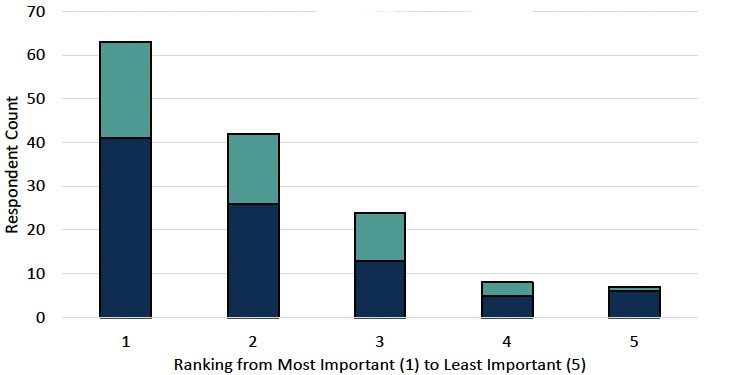
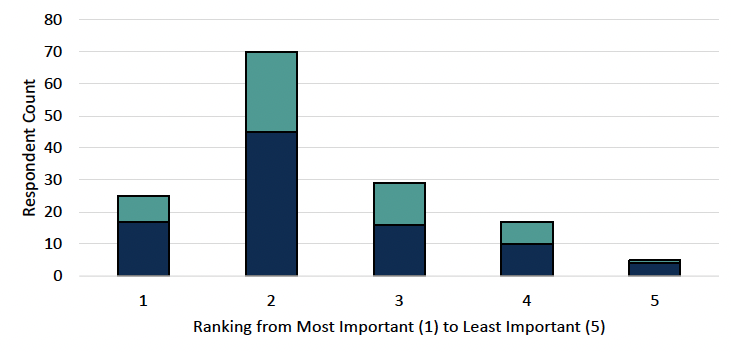
‘Other’ suggestions
Around 75 respondents made a further comment in relation to the ‘Other’ option.
One of the most frequent comments was a concern that, while communities should be involved in improving flood resilience, they should not be responsible for doing so. It was observed that some communities will not have the capacity to set up a local flood resilience group, and that many volunteers are already overstretched with other community activities. Associated points were that communities do not feel that they are being listened to by decision makers or that they lack any influence over the actions of local landowners.
‘Other’ actions suggested included:
- Sharing information about flooding with Scottish Water in addition to SEPA and local authorities, and working with authorities to develop response plans.
- Adding flood resilience actions to a Local Place Plan.
- Creating a register of people and businesses within the community who are able to help in a flood emergency and households who may require assistance because of ill health or disability.
- Raising awareness and sharing information within and between communities.
- Exploring and sourcing funding.
- Seeking external support and expertise including by engaging with the Scottish Flood Forum.
- Getting access to additional information – for example better rain forecasts and real time water levels.
- Installing additional flood mitigation measures for their own properties, including NFM measures where possible, and providing emergency equipment.
- Maintaining existing drainage systems if responsible for doing so.
- Reviewing and updating flood resilience plans at regular intervals.
Question 8: What actions could householders/businesses take to improve their flood resilience? (Please rank from most to least important)
Six options were presented at this question:
- Learn about flood exposure in their area
- Invest in property resilience measures, such as installing flood gates, raising electrical wall sockets and using flood resilient building materials
- Join a community flood action group
- Sign up to Floodline for flood alerts and warnings
- Seek advice on flood resilience
- Make sure they have flood insurance.
Around 175 respondents responded to this question.
Most and least preferred options
By some margin, respondents were likely to see learning about flood exposure in their area as the most important action that householders or businesses could take; as illustrated in Figure 9, 76 respondents ranked this option as most important.
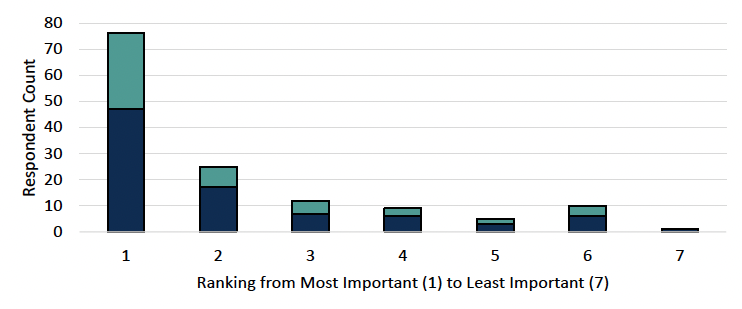
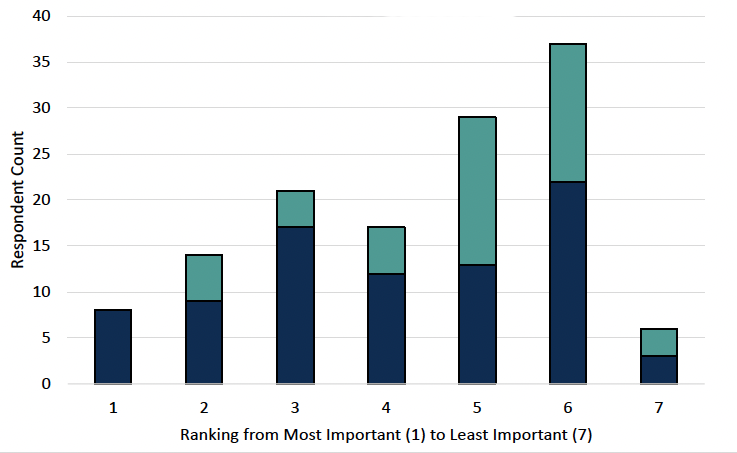
Of the remaining choices, ‘seeking advice on flood resilience’ and ‘signing up to Floodline for flood alerts and warnings’ tended to be ranked as of middling importance, and – as shown in Figure 10 – ‘joining a community flood action group’ as of lesser importance.
‘Other’ suggestions
Around 65 respondents made a further comment in relation to the ‘Other’ option.
Some respondents noted that one of the suggested options – making sure flood insurance is in place – may not be possible. It was also argued that while homeowners should know that their property is at risk, tenants may not, and it was suggested that landlords should ensure knowledge of flood risk is communicated to new or existing tenants upon lease agreement.
Among ‘other’ actions suggested the most frequent were:
- Preparing a household or business flood plan.
- Householders installing small scale NFM measures to reduce run off. Examples included rain gardens, porous paving, green roofs and ponds, planting trees and aerating compacted soils. It was argued that when enacted at scale, many small, inexpensive actions can come together to make a positive change to the environment. Businesses integrating green and blue infrastructure into their properties and surrounding environments could also increase resilience.
Further ideas for householders included:
- Understanding negative impacts of their own actions – such as block paving driveways – in contributing to flood risk.
- Maintaining existing property resilience measures.
- Participating in local flood drills.
- Sharing learning after each experience to trigger additional protection activities.
Question 9: What would you do to improve your personal flood resilience? (Please rank from most to least important)
Six options were presented at this question:
- Find out how exposed you are to floods
- Sign up to Floodline for flood alerts and warnings
- Have a personal flood plan ready to put into action when flooding is expected
- Ensure you know what to do if your property was to get flooded
- Check your flood exposure before buying or renting a property
- Make sure you have flood insurance.
Around 160 respondents responded to this question.
Preferred options
Respondents were most likely to say that ‘checking flood exposure before buying or renting a property’ and ‘finding out how exposed they were to floods’ were the most important things they could do to improve their personal flood resilience[4]. ‘Checking flood exposure before buying or renting’ was ranked as most important by 55 respondents and ‘finding out how exposed you are to floods’ was ranked as most important by 53 respondents.
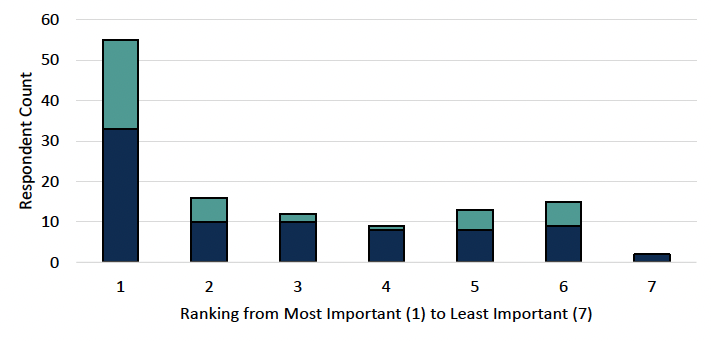
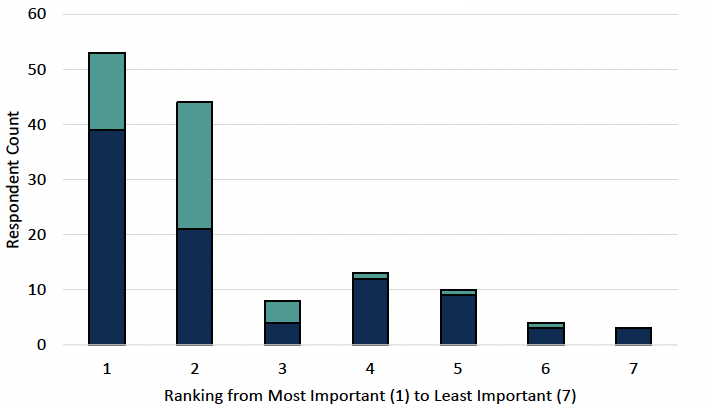
The other options were relatively evenly ranked, although ‘ensuring you know what to do if your property was to get flooded’ tended to be seen as least important.
‘Other’ suggestions
Around 50 respondents made a further comment in relation to the ‘Other’ option.
Suggestions for ‘other’ actions that the respondent would/might take to improve their personal flood resilience included:
- Investing in property resilience measures.
- Maintaining existing measures.
- Joining a group or developing a support network.
- Taking steps to reduce run off from their own property.
- Responding to local planning applications that could impact run off and drainage.
- Keeping evidence (e.g. photographs) of flooding events.
Contact
Email: flooding_mailbox@gov.scot
There is a problem
Thanks for your feedback